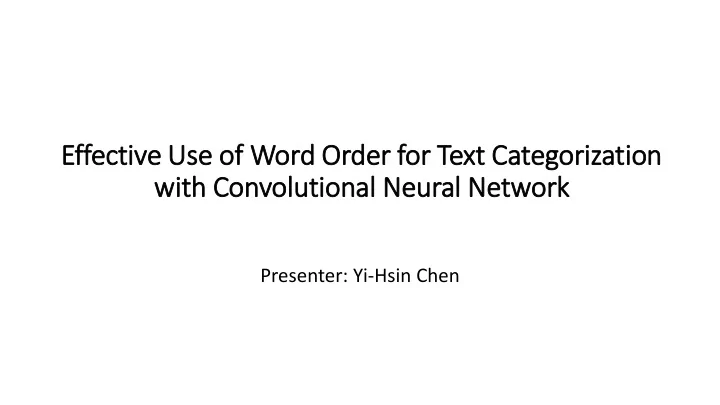

Effective Use of f Word Order for Text xt Categorization wit ith Convolutional Neural Network Presenter: Yi-Hsin Chen
Text xt Categorization • Automatically assign pre-defined categories to documents written in natural language • Sentiment Classification • Topic Categorization • Spam Detection
Pre Previous Works • First representing a document using a bag-of-n-gram vector and then using SVM for classification • Lose information of word order • First converting words to vectors as the input, then using Convolutional Neural Network (CNN) for classification • CNN output will retain the word order information • The word embedding might need separate training and additional resources
N-Gr Gram • A set of co-occuring words within a given window • For example, given a sentence “How are you doing” • For N=2, there are three 2- gram: “How are”, “are you”, “you doing” • For N=3, there are two 3- gram: “How are you”, “are you doing”
Convolutional Neural Network (1 (1/2) Output • Convolution Layer • The output will retain the location information • Usually the input is a 3-D matrix (Height x Width x Channel) rather than a 2-D one Key • Followed by a non-linear activation function, ex: reLU = max(0, x) • Key Parameters: • Kernel size Kernel • Stride / Padding • # of Kernel Input
Convolutional Neural Network (2 (2/2) 1 0 2 4 • Pooling Layer 5 6 6 8 • Pooling down-samples the input spatially 2 5 1 0 • The pooling function could be any function you want, 1 4 3 4 the two most common ones are: 1) Max Pooling 2) Average Pooling • Key Parameters: Kernel: 2x2 • Kernel Size Stride: 2 • Stride / Padding Avg. Pooling Max Pooling 3 5 6 8 3 2 5 4
Vie iew Sentences as Im Images • View each word as a “pixel” of an image Hi, how are you doing? Words 0 0 0 0 1 0 1 0 0 0 One-Hot V: # of words in 1 0 0 0 0 Vectors vocabulary 0 0 1 0 0 0 0 0 1 0 N: # of words in the sentence Stack Vectors to an “image” 1 x N x V “Image” Hi, how are you doing? Apply CNN 1 x p kernel
Pr Proposed Models • Directly apply CNN to learn the embedding of a text region Output • Seq-CNN: treat each word as an entity • For a 1 x p kernel, there will be p x V parameters Output Layer • Harder to train, easier to overfit Pooling Layer • Bow-CNN: treat p words as an entity • Reduce # of parameter from p x V to V Convolution Layer • Lose the order information for these p words • Parallel-CNN: use multiple CNNs in parallel to learn Input multiple types of embedding to improve performance
Se Seq-CN CNN v.s .s. . Bow-CN CNN Hi, how are you doing? Words 0 0 0 0 1 0 1 0 0 0 One-Hot 1 0 0 0 0 Vectors 0 0 1 0 0 0 0 0 1 0 Seq-CNN Bow-CNN T T 0 0 1 0 0 | 0 1 0 0 0 0 1 1 0 0
Ex Experi riment • Dataset • IMDB: movie review (Sentiment Classification) • Elec: electronics product reviews (Sentiment Classification) • RCV1 (topic categorization) • Performance Benchmark (Error Rate) • The proposed models outperform B/L • The model configuration for sentiment classification and topic categorization is quite different
Model Configuration for Dif ifferent Tasks • Sentiment Classification: a short phrase that conveys strong sentiment will dominate the results • Kernel size is small: 2~4 • Using global max pooling • Topic Categorization: need more context to provide information, the entire document matters, the location of text also matters • Kernel size is large : (20 for RCV1) • Using average pooling with 10 pooling units
CN CNN v.s .s. . Bag-of of-n-gram SVM (1 (1/2) • By directly learning the embedding of n-gram (n is decided by the kernel size), CNN is more able to utilize higher order n-gram for prediction Model CNN SVM Positive Works perfectly! ,love this product Great, excellent, perfect, Very pleased! I am pleased love, easy, amazing … Negative Completely useless., return policy Poor, useless, returned, It won’t even, but doesn’t work not worth, return … Predictive text region in the training set of Elec. dataset
CN CNN v.s .s. . Bag-of of-n-gram SVM (2 (2/2) • With the bag-of-n-gram representation, only the n-grams that appear in training data could help prediction • For CNN, even a n- gram doesn’t appear in the training data, once its constituent words does, it could still be helpful for prediction Model CNN Positive Best concept ever, best idea ever, best hub ever, am wholly satisfied … Negative Were unacceptably bad, is abysmally bad, were universally poor … Predictive text regions in the testing set which don’t appear in the training set
Thank You For r Your Attention!!!
Recommend
More recommend